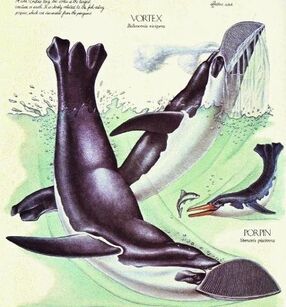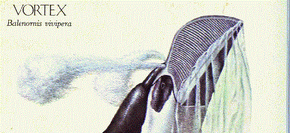
At over 12 meters long, the vortex is the largest creature on Earth in the Posthomic period. It is closely related to the fish-eating porpins, which are also descended from the penguins.
The vortex, Balenornis vivipera, is a huge, baleen whale-like pelagornid from the waters around Antarctica in After Man: A Zoology of the Future.
In contrast with the vast Antarctic continent, which in the Posthomic supports life only around the edges, the surrounding Southern Ocean teems with life. Among its most notable inhabitants is the vortex, the largest animal found anywhere in the world at 30 tonnes and over 12 meters in overall length including its 2.75-meter beak. Resembling many of the sea creatures of the past, it has a long, tapering, neckless body, a powerful paddle-shaped tail and long stabilizing flipper-wings (an ideal arrangement for efficient movement through water). Similar shapes can be seen in the great arthrodires of the Late Siluian to Late Devonian, in the pliosaurs of the Early Jurassic to Late Cretaceous and in the whales of the first half of the Cenozoic (the last creatures to occupy this ecological niche before the vortex and its relatives).
The vortex is in fact descended from the penguins, which, although they were birds, had long since lost the power of flight and were totally adapted to a semiaquatic life excepting for one thing (they always had to come on shore to lay

The vortex is a plankton-eater. Its massive beak has evolved into an effective sieve.
eggs). This remained so until, shortly after the extinction of the whales, one species of penguin developed the ability to retain its single egg internally until it was ready to hatch and gave birth to live young in the open ocean, making it the first ovoviviparous bird. Freed of the necessity to come ashore, this species became completely marine and ultimately gave rise to a completely new order of marine birds, the Pelagornids, of which the smaller porpin is the commonest surviving example.
Although a plankton-eater and very much larger, the vortex is also a member of the Pelagornid order. Its beak has developed into a large plankton sieve, which consists of a very fine mesh of bone plates instead of coalesced hair, as in the case of the whales' baleen plates.
